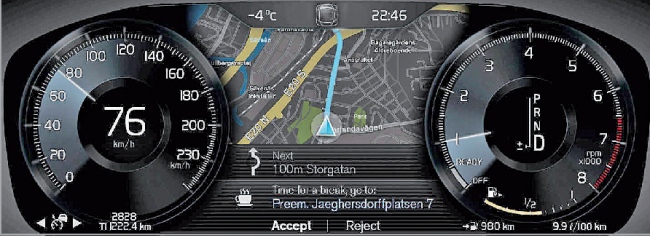+ A
A -
NYT Syndicate
It's something that many of us have experienced while driving, though we may not like to admit it. It's called a microsleep, a brief state of drowsy unconsciousness that can happen even if your eyes remain open.
Drowsy driving kills. According to the National Highway Traffic Safety Administration, drowsy driving caused 824 deaths in 2015, the last year for which figures are available.
Several manufacturers, including Audi, Mercedes and Volvo, currently offer drowsiness detection systems that monitor a vehicle's movements, such as steering wheel angle, lane deviation, time driven and road conditions. When drowsiness is detected, drivers are typically warned with a sound and the appearance of a coffee cup icon.
But manufacturers and automobile suppliers are now working on advanced technological solutions that go beyond visions of coffee cups.
To find out if drowsiness can be detected even earlier, Plessey Semiconductors has developed sensors, to be placed in a seat, that monitor changes in heart rate.
Algorithms developed by the company indicate when breathing changes to patterns that are typical of someone who is sleeping, giving a warning before someone actually feels tired.
Bosch, a German supplier of technology to many automotive companies, is developing a camera-based system that will monitor head and eye movements, as well as body posture, heart rate and body temperature.
When such a system is used in vehicles that allow for limited autonomous driving, the vehicle could take over once drowsiness is detected ” either coming to an emergency stop or pulling itself off to the side of the road.
In addition, sensors on the outside of the vehicle will monitor the state of traffic in which the fatigued driver is engaged. Once vehicles can communicate with each other ” a capability expected in the next few years ” other cars will be able to take appropriate manoeuvres to avoid the drowsy driver.
In France, Valeo, another supplier of automotive technology, is developing an infrared camera system that will monitor children in the rear seat as well as the driver's shoulder, neck and head movements, looking for deviations from the norm.
Checking body temperature and even how the driver is dressed, the system will also be able to customise the interior temperature for each driver, said Guillaume Devauchelle, the company's innovation director.
Nvidia, chip supplier to Audi, Mercedes, Tesla and others, is developing the Co-Pilot, an artificial-intelligence tool that can learn the behaviours of individual drivers and determine when they are operating outside their norms.
The system will eventually learn a driver's standard posture, head position, eye-blink rate, facial expression and steering style, among other indexes. Based on a vehicle's capabilities, the driver will be warned or automatically driven to a safe spot when conditions warrant.
Until vehicles can drive themselves, it will be up to drivers to pull over once they feel drowsy. But drivers tend to make excuses, believing there is no danger because they are just a few minutes from home, or they are not really as tired as they may feel.
To encourage drowsy drivers to take a break, Volvo, with a grant from the European Commission, is studying the effects of offering drivers free coffee once erratic steering wheel movements, lane departures and other signs detect that they are falling asleep, using the navigation system to direct them to the nearest coffee stop.
Audi is faced with a unique problem because of its scheduled introduction next year of a car capable of driving up to 35 mph without any driver intervention. When its Traffic Jam Pilot feature is engaged, the vehicle will need to determine if a driver is alert enough to take control after being a passive passenger for long periods.
Through its Driver Availability Detection system, sensors will scan the head and face to ensure that the eyes are open and the driver is alert before the car turns over the steering wheel.
Advanced drowsiness detection systems exist today. For example, Mercedes' Attention Assist monitors a driver's behaviour for the first 20 minutes behind the wheel to get a baseline of behaviours. Then, the system checks those against as many as 90 indexes, such as steering wheel angle, lane deviation and external factors such as wind gusts and pothole avoidance.
For the past decade Volvo has offered its Driver Alert system. The system detects drowsiness with 97 percent accuracy.
While NHTSA reported 824 deaths in 2015 because of drowsiness, that number is likely to be considerably higher, the agency said. Drowsy driving can only be self-reported and not measured like drunkenness. Also, drowsiness is not reported when it is a complication of other factors like excessive drinking.
Regardless of how good technology is at detecting drowsiness, fighting off sleep is futile. Because sleep is a biological need, the best solution for drivers is still a low-tech one: Pull over and take a nap.

